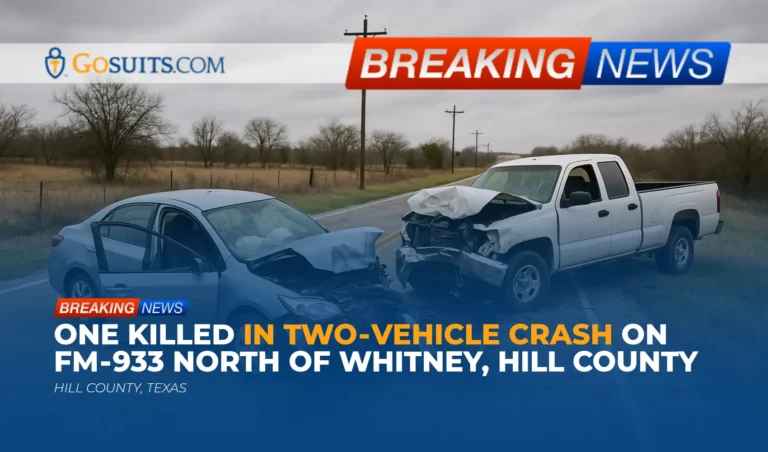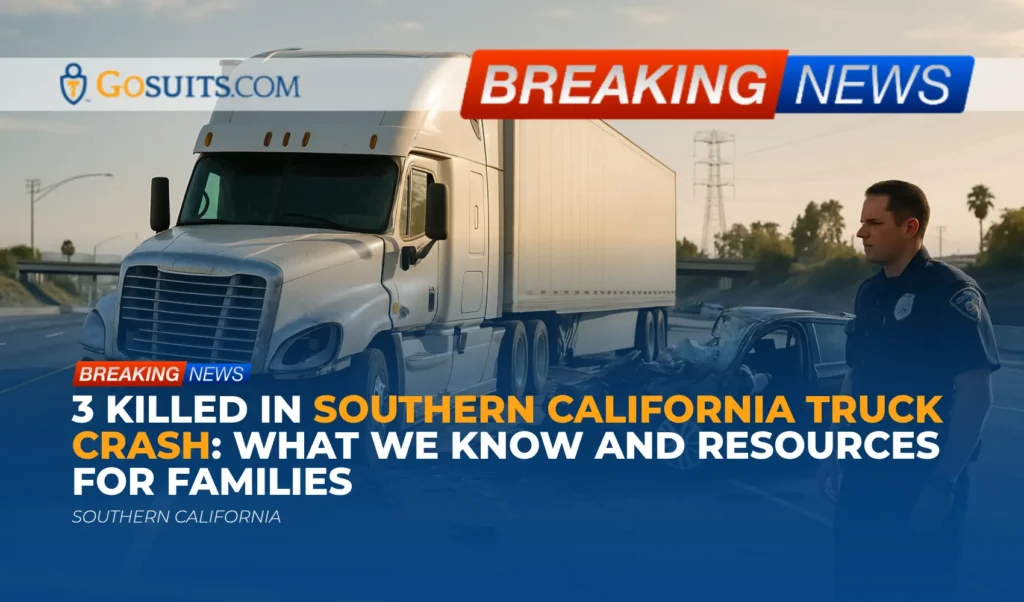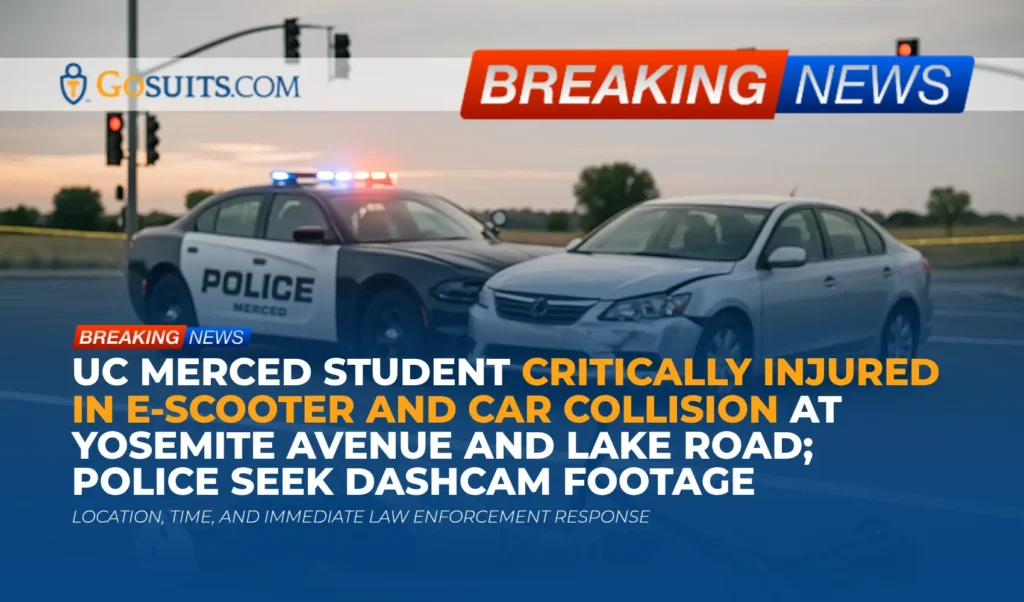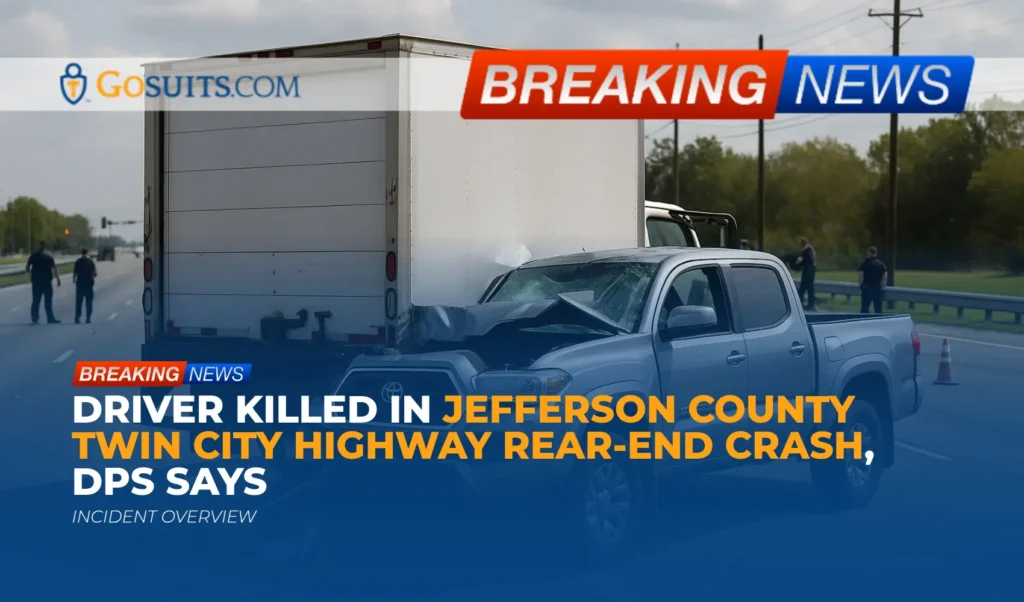One Person Killed in Two‑Vehicle Crash on FM‑933 North of Whitney, Hill County, Texas — What Families Need to Know
- Summary of the incident
- Who was involved
- Where and when it happened
- Law enforcement commentary and status of the investigation
- Legal and safety implications (civil side)
- Insurance issues families should expect
- Important records and people to contact (where to call)
- What evidence to preserve and request
- Steps families should take right now
- Timing and deadlines (statutes of limitations and claims timing)
- How fault and damages may be determined in Texas
- Resources and reliable government references
- Commentary from Gosuits Whitney, Texas Personal Injury Attorney
- Frequently Asked Questions (FAQs)
Summary of the incident
According to local reporting of a Texas Department of Public Safety (DPS) investigation, a two‑vehicle collision occurred on FM‑933 near the intersection of FM‑1713 north of Whitney in Hill County, Texas. A northbound Toyota RAV4 crossed the center dividing line and collided head‑on with a southbound GMC Sierra. The Toyota overturned. Both drivers were taken to local hospitals; the driver of the Toyota, an 84‑year‑old male from Whitney, was later pronounced dead. Next of kin were notified and the DPS investigation was described as active and ongoing.
This article explains the civil and practical steps families commonly face after a fatal traffic collision, the records and agencies that typically become involved, what to ask for, and general information about how fault and insurance claims are handled in Texas. The information here is for educational purposes and general information only.
Who was involved
- Deceased driver (per DPS reporting): an 84‑year‑old male resident of Whitney, Texas, identified by authorities as the driver of the Toyota RAV4.
- Other driver: occupant of the GMC Sierra, transported to a local hospital (survived and being treated).
- Responding agency: Texas Department of Public Safety troopers responded to and are investigating the crash. Sergeant Ryan Howard was identified as the DPS spokesperson for the incident.
Names beyond the reporting above should be treated cautiously until official records are released and next of kin notifications are confirmed. This article avoids naming private individuals beyond what public reporting already stated.
Where and when it happened
- Location: FM‑933 near the intersection of FM‑1713, north of Whitney, Hill County, Texas.
- Timeframe: The collision occurred in the evening; DPS reported the troopers responded at approximately 6:35 p.m. on the date reported by local media. The investigation remains active.
Law enforcement commentary and investigation status
Texas DPS reported the preliminary investigation indicated the Toyota RAV4 crossed the center dividing line and collided with the GMC Sierra. DPS indicated both drivers were taken to local hospitals and that next of kin had been notified for the deceased driver. Because the investigation is active, DPS may collect vehicle damage evidence, scene measurements, witness statements, any available surveillance or dashcam footage, and toxicology testing if conducted. Final determinations, including possible citations or criminal charges, are handled through the appropriate law enforcement or prosecutorial channels — separate from civil liability issues.
For ordering official crash reports or for updates from DPS, families can consult the Texas DPS crash records information (see Resources below).
Legal and safety implications (civil perspective)
From a civil personal‑injury and wrongful‑death perspective, some typical legal issues that arise in a fact pattern where a vehicle crossed the center line and struck another vehicle include:
- Potential negligence: Crossing a marked center line and striking an oncoming vehicle often creates a presumption of negligence or fault in civil claims. A plaintiff (or surviving family) would typically need to show the driver breached a duty of care (for example, by failing to keep right of center), and that breach caused the fatal injuries.
- Liability sources: A civil claim for wrongful death or survival damages is usually brought against the at‑fault driver or the at‑fault driver’s estate. If the at‑fault driver was acting within the scope of employment at the time (for example, driving a work vehicle), an employer or vehicle owner may also bear responsibility. Insurance companies that issued policies to the at‑fault driver or vehicle owner typically handle payment of covered damages, subject to policy limits.
- Comparative responsibility: Texas applies a proportionate responsibility system. If multiple parties share fault, any recovery can be reduced in proportion to the injured party’s own degree of responsibility. Texas law bars recovery if the plaintiff is more than 50% responsible. (See Texas statutes on proportionate responsibility in the Resources section.)
- Wrongful death vs. survival actions: Texas statutory law distinguishes between a wrongful‑death cause of action (for the survivors of the deceased) and a survival action (claims the deceased could have brought prior to death). Different recoverable damages and different beneficiaries may apply; statutes govern who may bring a wrongful‑death claim and what damages are available.
Because every case is fact‑specific, families often benefit from speaking with an attorney to learn how Texas law may apply to their situation.
(For statutory resources see the Resources section below.)
Insurance issues families should expect
- Potential insurance sources: The at‑fault driver’s auto liability insurer is typically the first source of compensation for wrongful death and funeral and medical expenses arising from a fatal crash. If the at‑fault driver is uninsured or underinsured, the deceased’s family may explore uninsured/underinsured motorist coverage on the deceased’s own auto policy, if present.
- Policy limits and investigations: Insurers will investigate promptly. They may request official reports, medical and hospital records, autopsy results (if released), and recorded statements. Anything a family member says to an insurer can be used later during claims negotiations, so it is generally prudent to get legal guidance before making recorded statements.
- Common insurer practices: Insurance companies have adjusters whose role is to evaluate and minimize the company’s financial exposure. That can mean early settlement offers that may not fully account for long‑term or non‑economic damages (such as loss of companionship). Speaking with an attorney before giving recorded statements or accepting a settlement is often advisable.
Texas Department of Insurance provides consumer information about dealing with insurers (see Resources).

Important records and people to contact (where to call)
When a fatal crash occurs, key records and agencies families often need to contact include:
- Texas Department of Public Safety (DPS) — for the official crash report and any DPS‑generated investigative records. Families can request crash reports through DPS’s crash records information pages. (https://www.dps.texas.gov/section/traffic/crash-records)
- Local law enforcement agency that responded (if not DPS): For this crash, DPS troopers were the responding authority. For other incidents, family members may contact the county sheriff’s office or municipal police department to request the police report and information on the investigation.
- Hill County offices (county clerk or Sheriff’s Office) — to learn local procedures for obtaining records and for next steps with the coroner/justice of the peace. Contact details for local county offices may be found through county directories or local government webpages.
- Coroner / Medical Examiner or Justice of the Peace — to request the autopsy report, cause of death findings, and toxicology results. In Texas, coroners or justices of the peace handle death investigations in many counties; some counties use a medical examiner system.
- Local hospitals where the injured were taken — to request medical records (you will need proper authorization as next of kin or executor).
- Funeral home (if one has been selected) — for guidance about disposition and obtaining death certificates.
- Insurance companies — the deceased’s insurer and the at‑fault driver’s insurer should be notified, but families should strongly consider speaking to an attorney before providing statements or signing authorizations.
If you are uncertain which local office to call, the Texas Department of Public Safety can guide you on obtaining the crash report and which local agencies were involved (https://www.dps.texas.gov/section/traffic/crash-records).
What evidence to preserve and request
Preserving evidence early is important for civil claims. Key items to preserve and request:
- Official crash report(s) from DPS and local police.
- Photographs from the scene (ask investigators if they have photos or request copies).
- Photographs of vehicles involved showing damage and license plates.
- Vehicle repair and salvage records, if available.
- Witness contact information and statements.
- 911 call recordings (these are public records in many jurisdictions).
- Traffic camera, dashcam, or nearby surveillance video that may have captured the collision.
- Medical records and hospital admission records for anyone treated.
- Autopsy report and toxicology report (obtain from the coroner or medical examiner).
- Maintenance records for vehicles, if relevant.
- Any cellphone data, navigation, or electronic driving aids records if available and legally obtained.
Families should request copies of these records promptly because some evidence (for example, surveillance footage) may be overwritten or lost.
Steps families should take right now
- Notify next of kin and make immediate arrangements as needed for the deceased.
- Obtain the official crash report from Texas DPS once available. The report typically lists parties, vehicles, and a preliminary narrative. (https://www.dps.texas.gov/section/traffic/crash-records)
- Contact the coroner/medical examiner for information on autopsy and toxicology reports. Each county has local procedures; ask DPS or the county offices for contact information.
- Preserve evidence: collect any photos, witness names, and preserve vehicles if possible (do not authorize destruction).
- Do not provide recorded statements to the at‑fault party’s insurer before speaking with an attorney. What you say to insurance adjusters can affect later civil claims.
- Keep careful records of all expenses related to the crash (funeral, medical, travel, lost income).
- Consider consulting a seasoned personal‑injury attorney who handles fatal collision matters to understand rights and options. An attorney can explain statutory deadlines, potential claims, and how to communicate with insurers. (This is educational information, not legal advice.)
Timing and deadlines
- Statute of limitations: Under Texas law, most personal injury and wrongful death claims must be filed within two years from the date of death or injury. Missing the statute of limitations can bar a civil claim. (See Texas Civil Practice & Remedies Code for timing of actions.) (https://statutes.capitol.texas.gov/Docs/CP/htm/CP.16.htm)
- Evidence preservation: Some crucial evidence (video footage, vehicle parts, electronic data) can disappear quickly. Early action to preserve and request records is important.
Because procedural rules and deadlines are strict, families frequently consult an attorney early to protect rights and preserve claims.
How fault and damages may be determined in Texas
- Fault: On the civil side, fault is determined by evidence — official crash reports, scene photographs, witness statements, physical evidence, and expert analysis (accident reconstruction). A driver crossing a center line is commonly treated as a key fact in showing negligence, but the full context (mechanical failure, medical emergency, road conditions, or other drivers’ conduct) is considered.
- Damages: In wrongful death actions in Texas, recoverable damages can include funeral and burial expenses; loss of support, companionship, and guidance for survivors; mental anguish for certain family members; and, in survival actions, the deceased person’s pre‑death pain and suffering and medical bills. Specific recoverable items, who may recover them, and caps or limitations are governed by Texas statutes. (See Texas statutes on wrongful death and survival actions.) (https://statutes.capitol.texas.gov/Docs/CP/htm/CP.71.htm)
- Comparative fault: Texas applies proportionate responsibility; if the deceased shares fault, that percentage reduces recoverable damages. If the deceased is found more than 50% responsible, recovery may be barred. (https://statutes.capitol.texas.gov/Docs/CP/htm/CP.33.htm)

Resources and reliable government references
- Texas Department of Public Safety — Crash Records and how to obtain crash reports: https://www.dps.texas.gov/section/traffic/crash-records
- Texas Civil Practice & Remedies Code — Statutes on tolling, limitations, proportionate responsibility, and wrongful death/survival actions: https://statutes.capitol.texas.gov/Docs/CP/htm/CP.16.htm (limitations); https://statutes.capitol.texas.gov/Docs/CP/htm/CP.33.htm (proportionate responsibility); https://statutes.capitol.texas.gov/Docs/CP/htm/CP.71.htm (wrongful death and survival actions)
- Texas Department of Insurance — Consumer information on auto insurance claims and dealing with insurance companies: https://www.tdi.texas.gov/
- Centers for Disease Control and Prevention (CDC) — Motor vehicle safety information and statistics: https://www.cdc.gov/motorvehiclesafety/index.html
- National Highway Traffic Safety Administration (NHTSA) — Crash data and safety resources: https://www.nhtsa.gov/research-data
If you need local phone numbers for Hill County offices, the DPS crash report can identify the investigating agency; county websites or local government directories list coroner, sheriff, and county clerk contacts.
Commentary from Gosuits Whitney, Texas Personal Injury Attorney
We extend our deepest sympathies to the family and friends affected by this tragic crash north of Whitney. Losing a loved one in a sudden collision is devastating and creates immediate emotional and practical challenges.
This article is for educational purposes and to provide general information about civil options and practical next steps following a fatal traffic collision. Based on the reported facts — that a Toyota RAV4 crossed a center dividing line and collided with a GMC Sierra — the crossing of the center line is a significant fact in a civil examination of fault. If investigators confirm the vehicle crossed the center line without lawful justification, that fact will be central to any civil claims for wrongful death or survival damages.
Insurance companies and other corporations involved in these incidents often begin investigations immediately and may present early settlement offers. Because families are grieving and may lack familiarity with legal procedures, insurers sometimes rely on recorded statements or incomplete information to limit payouts. That is why it is important to know your rights and obtain guidance before signing releases or giving recorded statements. Consulting with a seasoned personal‑injury lawyer for a free consultation allows families to understand potential claims, deadlines, and what information should or should not be shared with insurers.
A free consultation does not obligate a family to proceed; it provides a confidential opportunity to learn about options and to ensure critical evidence and rights are protected early in the process.
Frequently, families worry about costs and the timing of claims. Because legal deadlines are strict and evidence may be time‑sensitive, timely consultation helps preserve rights and keeps options open while the family focuses on immediate needs.
(Again, this commentary is informational and not legal advice.)
If you have additional questions about the records mentioned here, how to preserve evidence, or next‑step options for civil claims, consider contacting the agencies listed in the Resources section or seeking a confidential consultation with a seasoned personal‑injury attorney to discuss your circumstances.






